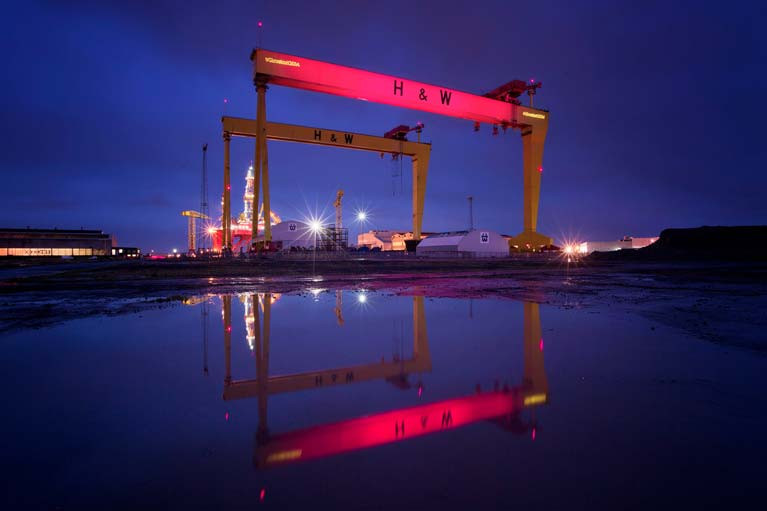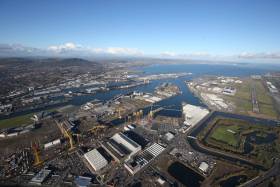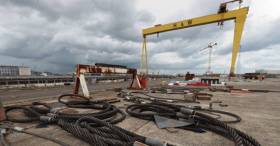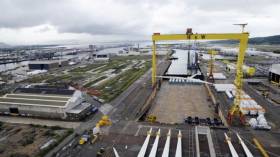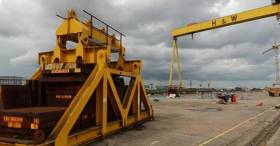Displaying items by tag: Harland & Wolff
Former First Sea Lord Joins Harland & Wolff Board
Parent company of Harland & Wolff, InfraStrata plc, is delighted to announce that former First Sea Lord & Chief of Naval Staff of the Royal Navy, Sir Jonathon Band, will be joining its Board of Directors.
Sir Jonathon is expected to formally join the Board by the end of August 2021.
Sir Jonathon Band is a former First Sea Lord & Chief of Naval Staff of the Royal Navy during which period he created a new innovative Command Structure in addition to promoting the need for maritime investment and security. Sir Jonathon has also worked very closely with the industry to promote and implement the Defence Industrial Strategy, a UK government policy focused on the efficient allocation of military equipment and resources to the UK armed forces.
Prior to his role as First Sea Lord, Sir Jonathon served as Commander in Chief Fleet during which time, as Chief Operating Officer, he was responsible for the operational capability and deployment of the Navy’s front line. Sir Jonathon is highly respected for his time spent in supporting foreign and defence policies and for his crucial role in negotiating and building coalitions across NATO allies and Middle Eastern partners.
Following his retirement from the Royal Navy, Sir Jonathon has held numerous non-executive positions at Lockheed Martin UK, Babcock International Group, National Museum of the Royal Navy and Survitec Group Ltd.
Sir Jonathon is currently a Non-Executive Director of Carnival Corporation, the NYSE & LSE listed global cruise operator.
Clive Richardson, Chairman of InfraStrata plc, commented: “I am very pleased that Sir Jonathon has agreed to join the InfraStrata board. With this appointment, the Board of InfraStrata will now consist of three non-executive directors and two executive directors, each one with significant experience in our key growth sectors. Sir Jonathon brings with him several decades of experience in the defence and wider marine markets. I look forward to working very closely with Sir Jonathon and for him to become an integral part of our Board as we move the business forward.”
Harland & Wolff is a multisite fabrication company, operating in the maritime and offshore industry through five sectors: commercial, cruise and ferry, defence, oil & gas and renewables and six services: technical services, fabrication and construction, decommissioning, repair and maintenance, in-service support and conversion.
Its Belfast yard is one of Europe’s largest heavy engineering facilities, with deep water access, two of Europe’s largest drydocks, ample quayside and vast fabrication halls. As a result of the acquisition of Harland & Wolff (Appledore) in August 2020, the company has been able to capitalise on opportunities at both ends of the ship-repair and shipbuilding markets where this will be significant demand.
In February 2021, the company acquired the assets of two Scottish based yards along the east and west coasts. Now known as Harland & Wolff (Methil) and Harland & Wolff (Arnish), these facilities will focus on fabrication work within the renewable, oil and gas and defence sectors.
Harland & Wolff is a wholly-owned subsidiary of InfraStrata plc (AIM: INFA), a London Stock Exchange-listed firm focused on strategic infrastructure projects and physical asset life-cycle management.
In addition to Harland & Wolff, it owns the Islandmagee gas storage project, which is expected to provide 25% of the UK’s natural gas storage capacity and to benefit the Northern Irish economy as a whole when completed.
Harland & Wolff, the iconic shipyard on Belfast Lough with over 160 years of maritime and offshore engineering pedigree, welcomed The Prince of Wales on 18 May 2021 to mark its 160th anniversary.
Arriving at Harland & Wolff (Belfast), His Royal Highness toured the yard, met with workers and signed the company Visitors’ Book. During this ceremony, The Prince was then presented with a framed photo of his late father, The Duke of Edinburgh, on a visit to the shipyard in 1977 along with an original copy of the ‘H&W News’ which featured The Duke of Edinburgh’s visit.
The Prince finished the visit by unveiling a celebratory plaque marking the 160th anniversary of Harland & Wolff.
Addressing staff, The Prince commented:
“I’m so pleased to hear that there is all sorts of potential new activity here and new fabrication opportunities, that could be really encouraging, and I hope you could encourage a lot more of the young to become apprentices and understand the importance of manufacturing and to also understand how this country has led the way in so many of these areas.”
“We owe all of you an enormous debt of gratitude for your skills and ingenuity, which are so remarkable. Well done all of you and thank you for all the hard work you put in.”
Founded on April 11 1861 by Sir Edward James Harland and Gustav Wilhelm Wolff, Harland & Wolff’s heritage includes work on some of the most iconic ships, including the famous RMS Titanic, RMS Olympic and HMHS Britannic, right through to the SS Canberra for P&O and the Myrina tanker – the first supertanker built in the UK.
John Wood, Group CEO commented: “It has been a pleasure to welcome His Royal Highness onto site to commemorate our 160th anniversary. As one of the most iconic names in shipbuilding, this visit marks an incredible moment in our history. We have a great past, and now we’re proud to be building a great future. Through our newly launched apprenticeship scheme, we will continue to pass on those skills and traditions and in doing so, put British shipbuilding back on the map. This is no mean feat but as one team, we will return Harland & Wolff to its former glory.”
Harland & Wolff is a multisite fabrication company, operating in the maritime and offshore industry. Its Belfast yard is one of Europe’s largest heavy engineering facilities, with deep water access, two of Europe’s largest drydocks, ample quayside and vast fabrication halls. As a result of the acquisition of Harland & Wolff (Appledore) in August 2020, the company has been able to capitalise on opportunities at both ends of the ship-repair and shipbuilding markets where this will be significant demand.
In February 2021, the company acquired the assets of two Scottish based yards along the east and west coasts. Now known as Harland & Wolff (Methil) and Harland & Wolff (Arnish), these facilities will focus on fabrication work within the renewable, oil and gas and defence sectors.
In addition to Harland & Wolff, it owns the Islandmagee gas storage project, which is expected to provide 25% of the UK’s natural gas storage capacity and to benefit the Northern Irish economy as a whole when completed.
Harland & Wolff, the iconic shipyard with over 160 years of maritime and offshore engineering pedigree has announced it has been awarded a contract by Saipem Limited for the fabrication and load-out of eight wind turbine generator (WTG) jacket foundations.
The jacket foundations will service the EDF Renewables and ESB owned Neart na Gaoithe Offshore Wind Farm project located in the outer Firth of Forth in Scotland. The contract schedule is due to commence from 1 July 2021 and is anticipated to create around 290 direct and indirect jobs.
The works for fabrication, consolidation and load-out of the eight WTG jacket foundations will principally be conducted at Harland and Wolff’s newly acquired Methil facilities in Scotland. Should there be an opportunity to further optimise the works programme and make the contract more cost-effective, Harland & Wolff and Saipem will work jointly to spread additional workstreams within the contract across its three other sites in Belfast, Arnish and Appledore.
With its unrivalled UK fabrication facilities, Harland & Wolff’s multi-site approach can reduced fabrication timelines by as much as 30% - offering project developers a faster route to project monetisation and de-risking fabrication projects by spreading work across three distinct but close-proximity geographies.
Harland & Wolff’s four sites offer a combined footprint of over 334.6 hectares, with well over 72,000m² of undercover fabrication capacity. Belfast comprises two of the largest drydocks in the UK, second largest in Europe, each at 356 metres and 556 metres in length whilst Arnish boasts the largest fabrication hall in Europe. Both the Arnish and Methil sites offer 580,000m² of total site area and 24,000 tonnes of quayside load-out capabilities, boasting an annual throughput tonnage estimated at over 100,000 tonnes.
John Wood, CEO of InfraStrata, commented: “We are delighted to have entered into this contract with Saipem and I believe that this contract paves the way for the execution and delivery of future fabrication contracts, a significant number of which are currently in advanced negotiations.
The geographical proximity of our Methil facility to the North Sea makes it an ideal site for fabrication and load-out to wind farm projects such as this. More importantly, it validates our strategic vision of expanding the Group’s fabrication footprint into regions that are strategically located within proximity to major wind farm projects. This will enable us to spread workstreams across our facilities to drive down costs, deliver against tight schedules and, crucially, align ourselves to the government’s goal of providing wind generated power to all homes in the UK by 2030.
I am confident that this is only the beginning of a stream of projects in our pipeline that we expect to come to fruition. We are hugely excited about the massive potential that this first contract has unlocked, and we look forward to working with Saipem to successfully deliver under it.”
Harland & Wolff is a wholly-owned subsidiary of InfraStrata plc (AIM: INFA), a London Stock Exchange-listed firm focused on strategic infrastructure projects and physical asset life-cycle management.
Harland & Wolff is a multisite fabrication company, operating in the maritime and offshore industry. Its Belfast yard is one of Europe’s largest heavy engineering facilities, with deep water access, two of Europe’s largest drydocks, ample quayside and vast fabrication halls. As a result of the acquisition of Harland & Wolff (Appledore) in August 2020, the company has been able to capitalise on opportunities at both ends of the ship-repair and shipbuilding markets where this will be significant demand.
In addition to Harland & Wolff, it owns the Islandmagee gas storage project, which is expected to provide 25% of the UK’s natural gas storage capacity and to benefit the Northern Irish economy as a whole when completed.
Harland & Wolff Shipyard Celebrate 160 Year Anniversary
Harland & Wolff, the national strategic asset, with four leading shipyards and fabrication facilities based in Belfast, Appledore, and Scotland is proud to be celebrating its 160th anniversary.
Founded on April 11 1861 by Sir Edward James Harland and Gustav Wilhelm Wolff, its heritage includes work on some of the most iconic ships, including the famous RMS Titanic, RMS Olympic and HMHS Britannic, right through to the SS Canberra for P&O and the Myrina tanker – the first supertanker built in the UK.
John Wood, Group CEO commented: “It is a great privilege to celebrate 160 years of Harland & Wolff. It is a brand that is steeped in history and is now going through a pivotal change that will see it industry-leading once again.
We have already started to invest in all our facilities, from Wilma the robotic welder in Belfast to the complete restoration of the Appledore dock gates. As technology advances, we are keen to adopt new and better ways of doing things across all of our facilities to ensure we are internationally competitive.
As we recruit the next generation of shipbuilder and fabricators through our apprenticeship scheme, you will not just see ships being built under Samson and Goliath, you’ll see work from across all our five markets from wind farm jackets to bridges, and warships.”
Pioneering twenty-first century offshore and maritime engineering, Harland & Wolff operates throughout five markets, offering six key services. Its Belfast yard is one of Europe’s largest heavy engineering facilities, with deep water access, two of Europe’s largest drydocks, ample quayside and vast fabrication halls. As a result of the acquisition of Harland & Wolff (Appledore) in August 2020, the company has been able to capitalise on opportunities at both ends of the ship-repair and shipbuilding markets where there is significant demand.
In February 2021, the company acquired the assets of two Scottish based yards along the east and west coasts. Now known as Harland & Wolff (Methil) and Harland & Wolff (Arnish), these facilities will focus on fabrication work within the renewable, oil and gas and defence sectors.
Harland & Wolff is a wholly-owned subsidiary of InfraStrata plc (AIM: INFA), a London Stock Exchange-listed firm focused on strategic infrastructure projects and physical asset life-cycle management.
In addition to Harland & Wolff, it owns the Islandmagee gas storage project, which is expected to provide 25% of the UK’s natural gas storage capacity and to benefit the Northern Irish economy as a whole when completed.
In Belfast’s world-famous Harland and Wolff shipyard where the Titanic was built, the horn which hasn’t been sounded for more than twenty years, reverberated loud and clear across the city on Thursday night at 8 pm in appreciation of NHS workers. The horn used to signal the end of a shift in a huge yard which had at its peak 30,000 workers.
Harland & Wolff managing director John Petticrew said: “We figured that it would be appropriate because they are unique times we are in, we thought we would sound a unique alarm. It is quite simple. It is to support all the essential workers who are working, like nurses and doctors and bus drivers, to show our support from Harland & Wolff, just the same as everybody else.”
In what has now become a regular occurrence across the UK on Thursdays, people come out to clap in appreciation of the thousands of NHS and Social Care staff as well as all front-line workers battling COVID-19. Over a period of three weeks, the applause has been extended to many more sectors such as Firefighters, Refuse Collectors and the Police.
The honour of sounding the horn fell to Harland and Wolff’s Health and Safety Manager Paul Beattie. He said, “We proudly applaud the work of all those involved in keeping us safe, fed and cared for and for those keeping the lights on, the streets clean and essential transport moving during these challenging days.”
In the accompanying applause, workers were seen on the top of one of the cranes in the yard.
Harland & Wolff is famous for having built most of the ships for the White Star Line. Other well-known vessels built by Harland & Wolff include the Olympic class RMS Titanic, RMS Olympic and the RMS Britannic. They also built ships for the Royal Navy, Shaw Savill, and Union Castle.
Belfast Shipyard Harland & Wolff Receives Non-Binding Offers
Administrators of the Harland and Wolff shipyard, reports BBC News, say they have received a number of non-binding offers to buy the business as a going concern.
The yard, best known for building the Titanic, was placed into administration earlier this month.
Administrators, BDO, said there are other interested parties which may result in further offers.
BDO has agreed with the unions to extend the unpaid temporary lay-off of staff until 30 September.
For more on this latest development at the east Belfast yard, click here.
Administrators at Harland & Wolff Won't Confirm ‘Credible’ Bids for Belfast Shipyard
Two "credible" bids, reports Belfast Telegraph, have now been received for the stricken shipyard Harland & Wolff, it's been claimed.
DUP leader Arlene Foster and the party's East Belfast MP Gavin Robinson made the claim following a meeting with business advisors BDO, who were appointed administrators two weeks ago.
However, BDO would not confirm whether two bids were now on the table, nor the identity of any firms behind the bids.
Harland & Wolff has been facing financial difficulties following a downturn in business and the bankruptcy of its Norwegian parent company Dolphin Drilling, formerly Fred Olsen Energy. And most of its 123 staff have been occupying the site for around four weeks as they repeat calls for the UK Government to renationalise the business.
Mr Robinson said he and Mrs Foster had held a "positive" meeting with the administrators.
The newspaper has more here to read on this ongoing story.
The administrators for Harland & Wolff have extended the temporary unpaid lay-off of workers in what a trade union said was a "light at the end of the tunnel" for the stricken shipyard.
As the Belfast Telegraph reports, business advisers BDO said they had agreed with trade unions that the majority of the 123 staff would continue their temporary lay-off - a move which staves off redundancy.
Staff have been holding a sit-in at the yard as unions called for renationalisation, although the Government has said its difficulties are a commercial issue.
Potential buyers had until midday yesterday (Thursday) to make an offer but the deadline has now been extended. Administrators said they hoped expressions of interest could translate into a viable offer .
East Belfast MP Gavin Robinson said: "This is welcome news and is a demonstration of the ongoing work to secure a positive outcome for the shipyard."
Mr Robinson added he was talking to government about how it could help the shipyard and would also meet the administrator with his party leader Arlene Foster on Monday.
Clikc here for more on the story
'Positive Talks' Over Harland & Wolff Shipyard Future
"Positive discussions" have been held regarding the sale of Belfast shipyard Harland and Wolff, according to the administrators.
The business, BBC News reports, entered administration earlier this month, with accountancy firm BDO overseeing the process.
The move places 120 jobs at risk and could spell the end of the firm, best known for building the Titanic.
BDO said it hoped the ongoing talks may lead to "credible offers".
"In light of this, the administrators, in tandem with the unions and workforce, are intending to continue the unpaid temporary lay-off initiated on our appointment beyond today," it added.
"The limited retained team of workers are continuing to maintain the site and assist the administrators in carrying out their duties."
More can be read here on this story.
A trade union, writes Belfast Telegraph, the GMB has said it's in talks with the administrators of Harland & Wolff about extending the temporary lay-off of staff beyond Friday, it has emerged.
GMB and the Unite union last week reached agreement with business advisers BDO, who were appointed administrators to the stricken shipyard last week, that workers would be laid-off temporarily in a move to stave off redundancy.
Unions have called for renationalisation of the firm, which was previously in government ownership in the 1980s and 1990s.
Yesterday Michael Mulholland of the GMB told the Belfast Telegraph the union is now in talks with the administrators about extending the lay-off, though no agreement has yet been reached.
More on the story can be read here.


























